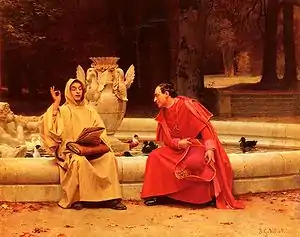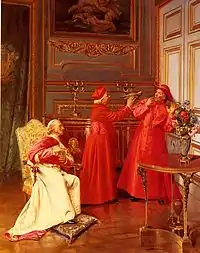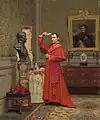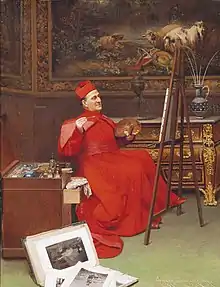Anti-clerical art
Anti-clerical art is a genre of art portraying clergy, especially Roman Catholic clergy, in unflattering contexts. It was especially popular in France during the second half of the 19th century, at a time that the anti-clerical message suited the prevailing political mood. Typical paintings show cardinals in their bright red robes engaging in unseemly activities within their lavish private quarters.

’A Fine Point’ by Jehan Georges Vibert. Note the direction of the cardinal’s gaze and the sculpture to the young monk’s right.
Nineteenth and early twentieth century artists known for their anti-clerical art include Francesco Brunery, Georges Croegaert, Charles Édouard Delort, Jehan Georges Vibert, Jules Benoit-Levy, Adolphe Henri Laissement and Eduardo Zamacois y Zabala.
See also
References
- Hook, Philip and Mark Poltimore, Popular 19th century painting, a dictionary of European genre painters, Woodbridge, Suffolk, Antique Collectors’ Club Ltd, 1985.
Examples of anti-clerical art
 Non Abiate Paura by Francesco Brunery
Non Abiate Paura by Francesco Brunery Friday by Charles Édouard Delort, private collection
Friday by Charles Édouard Delort, private collection The comparison by Jehan Georges Vibert, private collection
The comparison by Jehan Georges Vibert, private collection The Amateur Artist by Georges Croegaert, private collection
The Amateur Artist by Georges Croegaert, private collection.jpg.webp) Returning to the Monastery by Eduardo Zamacois y Zabala, 1868, Carmen Thyssen Museum
Returning to the Monastery by Eduardo Zamacois y Zabala, 1868, Carmen Thyssen Museum
External links
![]() Media related to Anti-clerical art at Wikimedia Commons
Media related to Anti-clerical art at Wikimedia Commons
This article is issued from Wikipedia. The text is licensed under Creative Commons - Attribution - Sharealike. Additional terms may apply for the media files.